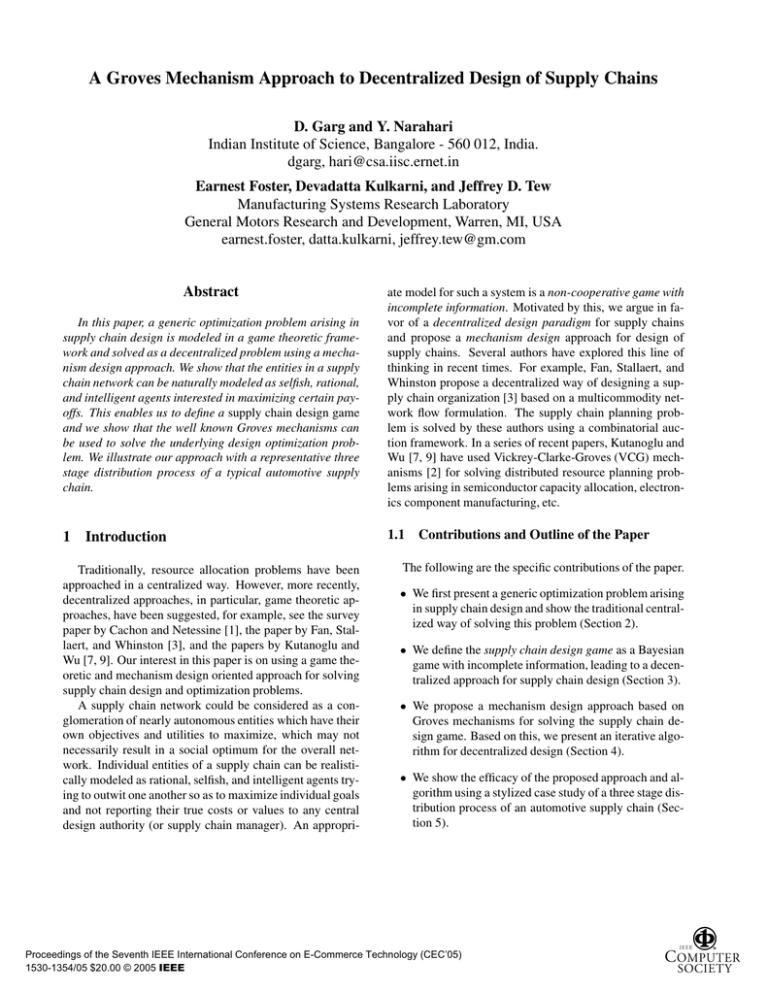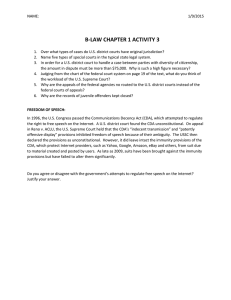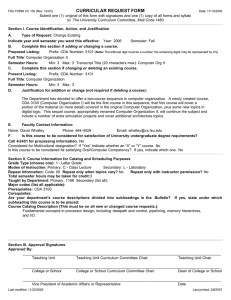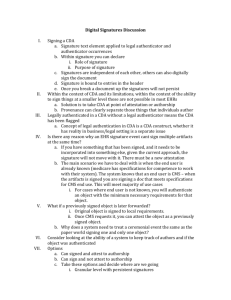A Groves Mechanism Approach to Decentralized Design of Supply Chains
advertisement

A Groves Mechanism Approach to Decentralized Design of Supply Chains
D. Garg and Y. Narahari
Indian Institute of Science, Bangalore - 560 012, India.
dgarg, hari@csa.iisc.ernet.in
Earnest Foster, Devadatta Kulkarni, and Jeffrey D. Tew
Manufacturing Systems Research Laboratory
General Motors Research and Development, Warren, MI, USA
earnest.foster, datta.kulkarni, jeffrey.tew@gm.com
Abstract
In this paper, a generic optimization problem arising in
supply chain design is modeled in a game theoretic framework and solved as a decentralized problem using a mechanism design approach. We show that the entities in a supply
chain network can be naturally modeled as selfish, rational,
and intelligent agents interested in maximizing certain payoffs. This enables us to define a supply chain design game
and we show that the well known Groves mechanisms can
be used to solve the underlying design optimization problem. We illustrate our approach with a representative three
stage distribution process of a typical automotive supply
chain.
1 Introduction
Traditionally, resource allocation problems have been
approached in a centralized way. However, more recently,
decentralized approaches, in particular, game theoretic approaches, have been suggested, for example, see the survey
paper by Cachon and Netessine [1], the paper by Fan, Stallaert, and Whinston [3], and the papers by Kutanoglu and
Wu [7, 9]. Our interest in this paper is on using a game theoretic and mechanism design oriented approach for solving
supply chain design and optimization problems.
A supply chain network could be considered as a conglomeration of nearly autonomous entities which have their
own objectives and utilities to maximize, which may not
necessarily result in a social optimum for the overall network. Individual entities of a supply chain can be realistically modeled as rational, selfish, and intelligent agents trying to outwit one another so as to maximize individual goals
and not reporting their true costs or values to any central
design authority (or supply chain manager). An appropri-
ate model for such a system is a non-cooperative game with
incomplete information. Motivated by this, we argue in favor of a decentralized design paradigm for supply chains
and propose a mechanism design approach for design of
supply chains. Several authors have explored this line of
thinking in recent times. For example, Fan, Stallaert, and
Whinston propose a decentralized way of designing a supply chain organization [3] based on a multicommodity network flow formulation. The supply chain planning problem is solved by these authors using a combinatorial auction framework. In a series of recent papers, Kutanoglu and
Wu [7, 9] have used Vickrey-Clarke-Groves (VCG) mechanisms [2] for solving distributed resource planning problems arising in semiconductor capacity allocation, electronics component manufacturing, etc.
1.1 Contributions and Outline of the Paper
The following are the specific contributions of the paper.
• We first present a generic optimization problem arising
in supply chain design and show the traditional centralized way of solving this problem (Section 2).
• We define the supply chain design game as a Bayesian
game with incomplete information, leading to a decentralized approach for supply chain design (Section 3).
• We propose a mechanism design approach based on
Groves mechanisms for solving the supply chain design game. Based on this, we present an iterative algorithm for decentralized design (Section 4).
• We show the efficacy of the proposed approach and algorithm using a stylized case study of a three stage distribution process of an automotive supply chain (Section 5).
Proceedings of the Seventh IEEE International Conference on E-Commerce Technology (CEC’05)
1530-1354/05 $20.00 © 2005 IEEE
2 A Generic Supply Chain Design Optimization Problem
The formulation here is on the same lines of [4].
Consider a make-to-order, linear supply chain with n
stages/partners/players. The processing time or lead time
for an end customer order at any stage i is a continuous random variable Ti . Let us assume that Ti ; i = 1, . . . , n are
independent random variables and there is no time elapsed
between the end of process i and commencement of process i + 1 (i = 1, . . . , n − 1). We assume that Ti is normally
distributed with mean µi and standard deviation σi . Under
these assumptions, the end-to-end lead timeY of unit orn
der for the supply chain is given by Y = i=1 Ti . Y is
n
normally
distributed with mean µ = i=1 µi and variance
σ 2 = ni=1 σi2 since it is the sum of n independent Gaussian random variables. Let us assume that for any stage i,
the parameters, µi and σi can take values from known sets
but otherwise are fixed. The cost of processing a single order at stage i is given by the function vi (µi , σi ). Note that
the function vi (µi , σi ) captures the cost versus delivery lead
time tradeoff at stage i. Let us assume that a Central Design
Authority (CDA) who is managing the overall supply chain
needs to determine optimal values for the parameters µi and
σi of each stage i so that a superior level of delivery performance is achieved at minimum cost. In what follows, we
formally define what we mean by superior level of delivery
performance. A more rigorous treatment can be found in
[4].
We assume that the CDA’s target is to deliver the orders
to the respective customers within τ ± T days of receiving
the order. We call τ the target delivery date and T the tolerance. We also define L = τ − T to be the lower limit of the
delivery window and U = τ + T to be the upper limit of the
delivery window. The process capability indices Cp , Cpk
and Cpm , which are popular in the areas of design tolerancing and statistical process control, can be used to measure
the performance of the end-to-end delivery process Y . See
[6, 8, 4] for a comprehensive treatment of process capability
indices. The three indices Cp , Cpk , and Cpm for the end-toend delivery process Y are defined in following way:
Cp
=
Cpk
=
Cpm
=
T
U −L
=
6σ
3σ
d
min(U − µ, µ − L)
=
3σ
3σ
T
U −L
= √
6ξ
3 σ 2 + b2
(1)
(2)
terms of its capability indices Cp , Cpk and Cpm in the following way [4].
Yield
=
Φ (3Cpk ) + Φ (6Cp − 3Cpk ) − 1
(4)
where Φ(.) is the cumulative distribution function of the
standard normal distribution. It can be verified that a unique
(Cp , Cpk ) pair results in a unique yield, therefore, the 3tuple (Cp , Cpk , Cpm ) can be substituted by the pair (Yield,
Cpm ) for the purpose of measuring the delivery performance. Being an indicator for precision and accuracy of
the deliveries, we prefer to call the yield of the process as
Delivery Probability (DP) and Cpm as Delivery Sharpness
(DS).
2.1 Supply Chain Design Optimization Problem
(SCOP)
The following parameters are known in a typical SCOP
problem.
1. The delivery window (τ, T ) as fixed by the CDA.
2. Mean µi of random variable Ti , i = 1, 2, . . . , n.
3. DP and DS (or Cpm ) for end-to-end lead time (Y ) as
fixed by the CDA.
4. Cost functions Ki = vi (σi ) submitted by each stage i
to the CDA. The function Ki captures the cost incurred
at stage i for attaining a standard deviation of σi in the
processing time of unit order at stage i. For the sake of
conceptual and computational simplicity, we choose a
second order polynomial of the form:
Ki = Ai0 + Ai1 σi + Ai2 σi2
(5)
The decision variables of the SCOP problem are the standard deviations σi∗ of each individual stage i (i = 1, . . . , n).
The objective of the SCOP is to minimize the end-to-end
delivery cost and the problem formulation becomes:
minimize
K=
n
i=1
Ki =
n
Ai0 + Ai1 σi + Ai2 σi2
(6)
i=1
subject to
(3)
DS for end-to-end lead time
DP for end-to-end lead time
≥
≥
∗
Cpm
DP ∗
(7)
(8)
The yield of the end-to-end delivery process Y plays a critical role in defining superior level of delivery performance.
The yield is simply the probability of delivering an order
within a specified interval τ ± T and can be expressed in
σi
>
0 ∀i
(9)
We focus on this optimization problem in the rest of this
paper.
Proceedings of the Seventh IEEE International Conference on E-Commerce Technology (CEC’05)
1530-1354/05 $20.00 © 2005 IEEE
2.2 Centralized Design Paradigm
In the centralized way of solving the SCOP problem, first
the CDA invites each stage to submit its cost function. After
receiving the true cost function from each stage, the CDA
solves an optimization problem that will minimize the total expediting cost while ensuring a required level of delivery performance. The solution of this optimization problem yields the optimal values for the design parameters (σi∗ )
which are communicated back to the respective stage by the
CDA. This scheme is shown in Figure 1.
vi : Xi → = True cost function (actual type) of stage i
wi : Xi → = Reported cost function (type) of stage i
w
Flo
STAGE 2
*
(σ )
1
v (
2
v (
1
σ1 )
Vi = {vi } = Set of possible types of stage i
Wi = {wi } = Set of possible reported types of stage i
σ2 )
*
(σ )
2
v (
3
σ3 )
CDA
STAGE 3
(Optimization
Solver)
*
(σ )
CUSTOMER
3
v
n−1
(
(σ
(n−1)
)
vn(
V = V1 × V2 × . . . × Vn
W = W1 × W2 × . . . × Wn
V−i = V1 × . . . × Vi−1 × Vi+1 × . . . × Vn
W−i = W1 × . . . × Wi−1 × Wi+1 × . . . × Wn
σn−1 )
*
Xi = {σi } = Set of values for standard deviation σi
X = X1 × X2 . . . × Xn
σ = (σ1 , σ2 , . . . , σn )
= A standard deviation profile of stages; σ ∈ X
STAGE 1
ial
ter
Ma
accurate information and arrive at optimal decisions. A crucial point of these compensation rules is they do not require
the organization leader to possess any additional information in order to compensate the employees or even to have
knowledge of the true accuracy or completeness of information. Before applying the Groves mechanism, we set up the
game model. Following is some notation that will be used
subsequently:
σn
)
(
*
σn
)
STAGE
(n−1)
STAGE
n
Figure 1. The centralized design paradigm
3 Supply Chain Design Game
A critical assumption in the centralized design paradigm
is that each stage of the supply chain is loyal to the CDA in
the sense that each stage honestly submits its cost curves to
the CDA. However, in most real world situations, the manager of each stage of a supply chain is typically selfish, rational, and intelligent and hence cares more about maximizing his/her own department’s and own employees’ welfare
rather than welfare of the whole organization. Therefore, it
should not be surprising if the managers of individual stages
report untruthful cost functions to the CDA (because, in
their perception, doing so may help them improve their own
individual utilities/welfare). In such a situation, the behavior of the entities (namely the individual stage managers) is
just like that of players in a noncooperative game. This motivates us to use an approach based on economic mechanism
design [2]. The theory of economic mechanism design, in
particular Groves mechanism [5, 2], basically suggests a
way in which the CDA can choose a set of compensation
rules that will induce the subunit managers to communicate
Let us assume that v, w, v−i , and w−i represent a typical element in the sets V, W, V−i , and W−i , respectively.
We make the following assumptions about the types of the
stages.
1. The standard deviation σi can take values from the set
(0, σi ], that is, Xi = (0, σi ].
2. The true type of any stage i is of the form
vi (σi ) = ai0 + ai1 σi + ai2 σi2 ∀σi ∈ (0, σi ]
where we assume that vi (σi ) is a non-negative and
non-increasing function of σi , that is, not all the three
coefficients ai0 , ai1 , and ai2 are non-negative simultaneously.
3. For each stage i, it is possible to obtain an interval for
each of the three coefficients ai0 , ai1 , and ai2 . That is,
ai0 ∈ ai0 , ai0 ; ai1 ∈ ai1 , ai1 ; ai2 ∈ ai2 , ai2
These intervals are such that choosing the coefficients
from the intervals will always result in a cost function vi (σi ) which is non-negative and non-increasing.
Also, for a given type vi (σi ), the values of all the three
coefficients lie in the corresponding intervals.
4. The previous assumption
enables
us to view
the type
set Vi of stage i as ai0 , ai0 × ai1 , ai1 × ai2 , ai2
which is a compact subset of 3 . The set V can also
Proceedings of the Seventh IEEE International Conference on E-Commerce Technology (CEC’05)
1530-1354/05 $20.00 © 2005 IEEE
now be viewed as a compact subset of 3n . Each point
of such a compact subset of 3n represents a unique
type profile of the stages.
5. Let Λi be a σ− algebra over the type set Vi (a compact
subset of 3 ). Let Λ be a σ−algebra over the set V
(a compact subset of 3n ) which is generated by the
algebras Λi .
6. We assume that P is a probability measure over the
σ−algebra Λ and hence (V, Λ, P ) forms a probability space. We call P as the common prior distribution
over type profiles of the stages and assume that it is
common knowledge among all the stages. Let V
represent the set of all the probability measures that
can be defined over the measurable space (V, Λ).
which is known only to the manager of stage i. On receiving a request from CDA, the ith stage manager reports a cost
function wi (σi ) to the CDA which may not be the same as
vi (σi ).
The problem of the CDA is to find an optimal standard
v (
1
SUBUNIT 2
I
w ( σ 2)
The Bayesian Game [10] underlying the design problem can
now be described as:
Γ
=
n
n
n
[{Ai }i=1 , {Vi }i=1 , {Wi }i=1 ,
n
n
{pi (.)}i=1 , {ui (.)}i=1 ]
(10)
where,
Ai
Vi
=
=
Wi
=
=
Manager of stage i of the supply chain
Set of possible types of stage i
ai0 , ai0 × ai1 , ai1 × ai2 , ai2
Set of possible reported types of stage i
pi
=
:
Action set for the manager of ith stage
Vi → V−i
=
Belief function for the manager of ith stage
4 Decentralized Design using Groves Mechanisms
Consider the SCOP problem shown in Figure 2. Here,
the mean processing time µi for each stage i is assumed to
be fixed and the problem of the CDA is to determine the
optimal value for standard deviation σi for each stage i. Let
us assume that vi (σi ) is the true cost function of stage i,
1 V
−i represents the set of all the probability measures that can be
defined over the measurable space (V−i , Λ−i )
w ( σ 1)
1
1
2
I
2
w ( σ 3)
3
v ( σ 3)
3
CDA
SUBUNIT 3
I
7. Let the manager of each stage i have a belief function pi : Vi → V−i 1 which describes the conjecture of stage i about the types of other stages given
its own type. That is, for any possible type set γi ,
where γi ⊂ Vi and γi ∈ Λi , pi (.|γi ) will be a probability measure over the measurable space (V−i , Λ−i )
and will represent what the ith stage manager would
believe about the type sets of other stages if his own
stage’s type set were γi .
SUBUNIT 1
ial
ter
Ma
w
o
l
F
v2 ( σ 2)
σ 1)
w
n−1
CUSTOMER
3
(σ n−1 )
I
n−1
w (σ n )
n
I
n
SUBUNIT
(n−1)
v
n−1
( σ n−1 )
SUBUNIT
n
v (σn )
n
Figure 2. The decentralized design paradigm
deviation profile, say (σ1∗ , . . . , σn∗ ), of the stages that will
result in the required level of delivery performance at minimum possible cost. The CDA can solve the above design
problem using some optimization solver with vi () replaced
by wi (). Let (σ̃1∗ , . . . , σ̃n∗ ) be the solution of the resulting
SCOP problem. If the CDA knows in advance that the managers of the various stages are selfish, rational, and intelligent then there is no reason for the CDA to believe that
that the cost functions reported are indeed their true cost
functions. Therefore, blindly solving the SCOP problem
will result in a non-optimal solution of the problem, that is
(σ̃1∗ , . . . , σ̃n∗ ) is not an optimal solution for the CDA’s problem. One way to tackle this situation is for the CDA to
offer an incentive Ii to each stage i, which is a function of
(σ̃1∗ , . . . , σ̃n∗ ), i.e. Ii : X1 × . . . × Xn → (see Figure 2),
so as to induce truth revelation. In such a case, the CDA
will first need to solve the problem in the usual centralized
fashion by simply assuming that the reported cost functions
by all the stages are indeed their true cost functions. This,
in general, will give a non-optimal solution (σ̃1∗ , . . . , σ̃n∗ ) of
the underlying SCOP problem. Then, based upon the solution (σ̃1∗ , . . . , σ̃n∗ ), the CDA will decide the incentive Ii for
each stage i. In such a case, the net payoff (utility) of stage
i will be equal to ui = Ii − vi (σ̃i∗ ) (in the literature, such
a utility function is known as quasi-linear utility function
[2]). Note that the payoff of stage i is dependent on what
Proceedings of the Seventh IEEE International Conference on E-Commerce Technology (CEC’05)
1530-1354/05 $20.00 © 2005 IEEE
cost functions are being reported by all the stages because
the reported cost functions wi will decide (σ̃1∗ , . . . , σ̃n∗ ) and
that in turn will determine the incentive Ii of stage i.
Now if the CDA can come up with an incentive structure (I1 , . . . , In ) such that the utility ui of each stage i gets
maximized only when its reported type is the same as its
true type, i.e. wi = vi , then each manager will understand
this fact and has no incentive to report an untruthful cost
function. The resulting solution will indeed be an optimal
solution, i.e. (σ̃1∗ , . . . , σ̃n∗ ) = (σ1∗ , . . . , σn∗ ). The Groves
Mechanism is a powerful way to construct such an optimal
incentive structure [5].
4.1 Groves Incentives
The Groves incentive Ii for stage i can be computed as
follows [5]:
wj (σ̃j∗ )
(11)
Ii = αi −
j=i
Step 0: Initial Bidding Phase The CDA invites the stages
to bid their cost functions and each stage bids its cost function wi (σi ) which need not be its true cost function.
Step 1: Allocation Phase The CDA solves the following
optimization problem. The solution of this optimization
problem yields the tuple (σ̃1∗ , . . . , σ̃n∗ ).
Minimize
K
ui (s1 , . . . , sn , vi )
=
ui (s1 , . . . , sn , vi , v−i )dpi (v−i |vi )
v−i ∈V−i
ui (s1 (v1 ), . . . , sn (vn ))dpi (v−i |vi )
=
v−i ∈V−i
ui (w1 , . . . , wn )dpi (v−i |vi )
=
v−i ∈V−i
=
[Ii (σ̃1∗ , . . . , σ̃n∗ ) − vi (σ̃i∗ )]dpi (v−i |vi )
v−i ∈V−i
[αi −
=
v−i ∈V−i
wj (σ̃j∗ ) − vi (σ̃i∗ )]dpi (v−i |vi )
j=i
We can prove easily that for the above utility function, the
truth revealing strategy profile st = (sti , . . . , stn ) is indeed
a dominant strategy equilibrium s∗ = (s∗1 , . . . , s∗n ) of the
underlying game which means adopting the incentive structure (11) will elicit true cost functions from the stages.
4.2 An Algorithm for Decentralized Design
We suggest following iterative algorithm which the CDA
can use to solve the SCOP problem in a decentralized manner.
n
wi (σi )
i=1
subject to
DS for end-to-end lead time
DP for end-to-end lead time
≥
≥
∗
Cpm
DP ∗
σi
>
0 ∀i
The CDA uses the tuple (σ̃1∗ , . . . , σ̃n∗ ) to compute the incentive Ii for each stage i in the following way:
where (σ̃1∗ , . . . , σ̃n∗ ) is the optimal solution of the underlying
SCOP problem with vi replaced by wi . αi is some constant
which can be assumed to be the same for all the stages and
can be used to normalize the value of Ii so that it has a
meaningful value. In such a case, the utility function ui for
stage i is given by
=
Ii = αi −
wj (σ̃i∗ )
j=i
The CDA allocates to each stage i a target of attaining the
σ̃i∗ variability. The CDA also allocates a fund of wi (σ̃i∗ ) to
meet the expediting expenditure. The CDA also allocates
an incentive Ii to stage i for its performance. Thus, the net
gain of stage i is Ii − vi (σ̃i∗ ).
Step 2: Iterative Bidding and Allocation
The CDA successively invites all stages to revise and
resubmit their cost functions if they wish to. Then each
stage i looks at its current allocation (σ̃i∗ , Ii ) and bids a
revised cost function wi (σi ) with the hope that in the next
round its net gain will improve. Some of the stages may
not revise their cost functions if they find that that their net
gains may not improve.
After receiving the revised bids from each stage, the
CDA again invokes Step 1 and solves the allocation problem. This initiates the next round of bidding and allocation.
This iterative bidding and allocation process continues until no stage revises its cost function. The process therefore
terminates when each stage bids the same cost function as
in the previous round.
We assert that above algorithm will converge to a point
where each stage bids its true cost function. The proof for
this assertion directly follows from the fact that the truth revealing strategy is a dominant strategy for each stage under
the Groves incentives structure (as already stated in Section
4.1). The convergence is guaranteed as long as the individual stages place improving bids if improvement is possible
and as long as the individual stages have enough computing
power to compute these improving bids.
Proceedings of the Seventh IEEE International Conference on E-Commerce Technology (CEC’05)
1530-1354/05 $20.00 © 2005 IEEE
5 A Case Study
To show the efficacy of the iterative algorithm, we
present a numerical experiment motivated by the outbound
logistics operations in a typical automotive supply chain.
Assume that a finished product (automotive vehicle) is
transported from plant first by truck, then by rail, and finally
by a truck to the dealer. We assume that each shipment leg is
in custody of a department manager who has an idea about
the delivery cost and the delivery performance of different
transportation service providers available for the leg. We
make the following assumptions:
1. The CDA has an ideal target of delivering a vehicle to
the dealer on the 30th ± 5 day counting from the day it
is ready for shipping at the plant.
2. There are three shipment legs in the journey of a vehicle from plant to dealer. We call these the first leg
(truck), the second leg (rail road), and the third leg
(truck). For each leg, there are alternate transportation service providers. We assume that there are 10
alternate service providers for each leg.
3. The mean shipment time of a vehicle on the first leg,
the second leg, and the third leg of its journey is 4 days,
21 days, and 7 days respectively. For each leg, the
mean is the same for all the alternate service providers
available for that leg.
4. For each leg, the variability in the shipment time as
well as the shipping cost for different alternate service
providers is a private information of the department
manager for the leg. Tables 1, 2, and 3 show the private
information
5. The shipment time at each leg is normally distributed
for all the service providers. Moreover, the shipment
times at the three legs are mutually independent.
∗
≥ 1.08
6. The CDA wishes to achieve Cp∗ ≥ 1.8 and Cpk
for the end-to-end lead time Y .
7. The manager of leg i (i = 1, 2, 3), uses his/her private information to compute the true cost function as a
quadratic function vi = ai +bi σi +ci σi2 , using the least
square curve fitting method. For the present instance,
these functions turn out to be:
v1 (σ1 )
v2 (σ2 )
v3 (σ3 )
= 022.638 − 16.017σ1 + 4.015σ12
= 231.085 − 68.624σ2 + 5.758σ22
= 052.255 − 29.827σ3 + 5.636σ32
Service
Provider
1
2
3
4
5
6
7
8
9
10
Standard Deviation
σ1 (days/unit )
0.25
0.50
0.75
1.00
1.25
1.50
1.75
2.00
2.25
2.50
Shipping Cost
K1 ($/unit )
20.00
15.00
12.00
10.00
09.00
08.00
07.50
07.25
07.00
07.00
Table 1. Private information of the manager
for the first leg
Service
Provider
1
2
3
4
5
6
7
8
9
10
Standard Deviation
σ2 (days/unit )
2.5
3.0
3.5
4.0
4.5
5.0
5.5
6.0
6.5
7.0
Shipping Cost
K2 ($/unit )
105
70
55
45
40
35
32
30
29
28
Table 2. Private information of the manager
for the second leg
Service
Provider
1
2
3
4
5
6
7
8
9
10
Standard Deviation
σ3 (days/unit )
0.75
1.00
1.25
1.50
1.75
2.00
2.25
2.50
2.75
3.00
Shipping Cost
K3 ($/unit )
35.0
27.0
22.0
19.0
18.0
16.0
14.5
13.5
13.0
12.5
Table 3. Private information of the manager
for the third leg
Proceedings of the Seventh IEEE International Conference on E-Commerce Technology (CEC’05)
1530-1354/05 $20.00 © 2005 IEEE
+(5.0σ12 + 6.0σ22 + 6.0σ32 )
5.1 Centralized Design
subject to
Each manager submits the true cost function and CDA
just solves the single optimization problem. For the above
case study, the CDA solves an appropriate optimization
problem. Using the Lagrange multiplier method it is easy to
show that the above optimization problem has global minimum at
σ1∗ = 0.2018 days, σ2∗ = 0.8284 days, σ3∗ = 0.3611 days
The optimal costs for the different legs and the total optimal
cost turn out be:
v1 (σ1∗ ) =
v2 (σ2∗ ) =
v3 (σ3∗ ) =
K∗ =
19.569 $/unit
178.190 $/unit
042.219 $/unit
239.978 $/unit
σ12 + σ22 + σ32
σi
I1t
I2t
=
=
α1 − (v2 (σ2∗ ) + v3 (σ3∗ )) = 29.591 $/unit
α2 − (v1 (σ1∗ ) + v3 (σ3∗ )) = 188.212 $/unit
I3t = α3 − (v1 (σ1∗ ) + v2 (σ2∗ )) = 052.241 $/unit
u1 (st1 (.), st2 (.), st3 (.)) = I1t − v1 (σ1∗ ) = 10.022 $/unit
u2 (st1 (.), st2 (.), st3 (.)) = I2t − v2 (σ2∗ ) = 10.022 $/unit
u3 (st1 (.), st2 (.), st3 (.))
= I3t − v3 (σ3∗ ) = 10.022 $/unit
Now will show a few iterations of our algorithm.
Round # 0
Step 0.1: Bidding Phase: In the initial bidding phase, each
manager submits a cost function wi (σi ) to the CDA that has
higher (than true) costs. Let us assume the following initial
cost functions as submitted by the managers:
T2
d2
25
=
=
2
∗2
29.16
9Cp∗
9Cpk
> 0 ∀i = 1, 2, 3
The solution of the above optimization problem results in
σ̃1∗ = 0.136 days, σ̃2∗ = 0.855 days, σ̃3∗ = 0.329 days
The CDA can use the above values to compute the incentives for the managers which turn out to be:
I1
=
I2
I3
=
=
α1 − (w2 (σ̃2∗ ) + w3 (σ̃3∗ )) = 13.759$/unit
α2 − (w1 (σ̃1∗ ) + w3 (σ̃3∗ )) = 178.832 $/unit
α3 − (w1 (σ̃1∗ ) + w2 (σ̃2∗ )) = 37.446 $/unit
Now the manager for each leg computes his/her own payoff
in following manner:
5.2 Decentralized Design
First, let us compute the incentives and net payoffs to the
managers in the case when each of them reveals the true
cost function, that is wi (.) = vi (); ∀i = 1, 2, 3. Assuming
α1 = α2 = α3 = 250 $/unit , it is easy to see that
=
u1
u2
u3
= I1 − v1 (σ̃1∗ ) = −6.789 $/unit
= I2 − v2 (σ̃2∗ ) = 2.209 $/unit
= I3 − v3 (σ̃3∗ ) = −0.598 $/unit
Round # 1
Step 1.1: Bidding Phase: Observe that in the previous
round, the net payoff of each manager is less than what
he/she would have got with a truth revealing strategy. However, it is not possible for a manager to compute his/her
payoff under a truth revealing strategy profile a priori because he/she does not know the actual cost functions of the
other managers. Therefore, each manager just tries to maximize his/her own payoff by hiking the costs. After knowing
the incentives Ii and variability target σ̃i∗ from the CDA in
the previous round, each manager will further revise his/her
cost function in a way that can hopefully fetch him/her more
payoff. Let us assume that the managers bid the following
cost functions in this round:
w1 (σ1 ) = 030.0 − 08.0σ1 + 7.0σ12
w1 (σ1 )
w2 (σ2 )
w3 (σ3 )
= 055.0 − 25.0σ3 + 6.0σ32
It is easy to verify that wi (σi ) ≥ vi (σi ); ∀σi ; ∀i = 1, 2, 3.
Step 0.2: Allocation Phase: In this phase, the CDA solves
the following allocation problem:
Minimize
K
w2 (σ2 ) = 250.0 − 60.0σ2 + 7.0σ22
= 25.0 − 10.0σ1 + 5.0σ12
= 240.0 − 65.0σ2 + 6.0σ22
=
3
wi (σi )
i=1
=
320 − (10.0σ1 + 65.0σ2 + 25.0σ3 )
w3 (σ3 ) = 060.0 − 20.0σ3 + 7.0σ32
It is easy to verify that wi (σi ) ≥ wi (σi ); ∀σi ; ∀i = 1, 2, 3.
Step 1.2: Allocation Phase: In this phase, the CDA solves
an appropriate allocation problem and the solution of the
problem results in:
σ̃1∗ = 0.127 days, σ̃2∗ = 0.954 days, σ̃3∗ = 0.318 days
Incentive and payoff for the manager of each leg turns out
to be the following.
I1
=
α1 − (w2 (σ̃2∗ ) + w3 (σ̃3∗ )) = −3.444$/unit
Proceedings of the Seventh IEEE International Conference on E-Commerce Technology (CEC’05)
1530-1354/05 $20.00 © 2005 IEEE
I2
=
I3
=
u1
=
u2
=
u3
=
α2 − (w1 (σ̃1∗ ) + w3 (σ̃3∗ )) = 166.560 $/unit
α3 − (w1 (σ̃1∗ ) + w2 (σ̃2∗ )) = 21.804
I1 − v1 (σ̃1∗ ) = −24.109 $/unit
I2 − v2 (σ̃2∗ ) = −4.259 $/unit
I3 − v3 (σ̃3∗ ) = −21.529 $/unit
$/unit
Round # 2
Step 2.1: Bidding Phase: Having realized the fact that hiking the cost is not improving payoffs, each manager slashes
the cost in this round. Let the bids received by the CDA in
this round be as follows:
w1 (σ1 )
= 023.0 − 14.0σ1 + 4.5σ12
w2 (σ2 )
= 235.0 − 67.0σ2 + 6.0σ22
w3 (σ3 )
= 054.0 − 27.0σ3 + 6.0σ32
It is easy to verify that wi (σi ) ≥ wi (σi ) ≥
vi (σi ); ∀σi ; ∀i = 1, 2, 3
Step 2.2: Allocation Phase: Solving the CDA’s problem in
a way similar to the previous two rounds, we get the following values for the various quantities.
σ̃1∗
=
I1
=
I2
=
I3
=
u1
=
u2
=
u3
=
0.1828 days, σ̃2∗ = 0.8419 days, σ̃3∗ = 0.3392
α1 − (w2 (σ̃2∗ ) + w3 (σ̃3∗ )) = 21.624 $/unit
α2 − (w1 (σ̃1∗ ) + w3 (σ̃3∗ )) = 183.878 $/unit
α3 − (w1 (σ̃1∗ ) + w2 (σ̃2∗ )) = 46.564 $/unit
I1 − v1 (σ̃1∗ ) = 1.780 $/unit
I2 − v2 (σ̃2∗ ) = 6.487 $/unit
I3 − v3 (σ̃3∗ ) = 3.779 $/unit
days
Thus, we see that as the cost function reported by a manager approaches the true cost function, the payoff for the
manager improves and and attains maximum value when
the manager reports the true cost function.
6 Conclusions
In this paper, we have use of game theory and mechanism design theory in proposing a new, realistic, and
promising way of designing supply chains. We showed
that a supply chain network is best viewed as a conglomeration of semi-autonomous or near-autonomous entities,
where the individual entities have their own individual goals
and utilities to optimize which may not necessarily result in
optimizing a system-wide objective. This leads to a noncooperative game model which we called the supply chain
design game. We then showed that mechanism design theory, in particular, Groves mechanisms, provides a natural
framework for modeling and analyzing the supply chain design game. The application of Groves mechanism design
approach to supply chains enables a central design authority
to determine incentives/penalties which induce truth revelation by individual entities of the supply chain. This in turn
leads to the design of high performance supply chains at
minimum cost. We showed the application of the proposed
approach to the design of a stylized version of a typical three
stage automotive distribution process.
The research has opened up a new approach for supply
chain design which is more realistic and natural. The approach needs to be developed into a comprehensive design
methodology for supply chain networks and this calls for
addressing many questions. (1) With modern supply chains
becoming information driven and with technologies such as
RFID tags driving revolutionary possibilities, how can one
leverage decentralized approaches such as proposed in the
paper towards a better design/operation of supply chains?
(2) What are the limits of anarchical behavior of selfish
agents in the supply chain design game? How can game
theory and mechanism design be applied to allow maximum
freedom to individual entities and yet maximize overall, social benefits?
Acknowledgments
The first two authors would like to acknowledge the generous support of General Motors R & D Center, Warren,
Michigan, USA, for supporting this research.
References
[1] G. Cachon and S. Netesssine. Game theory in supply chain
analysis. In D. Simchi-Levi, D. Wu, and Shen, editors, Supply Chain Analysis in the eBusiness Area. Kluwer Academic
Publishers, 2005.
[2] A. M. Colell, M. D. Whinston, and J. R. Green. Microeconomic Theory. Oxford University Press, New York, 1995.
[3] M. Fan, J. Stallaert, and A. Whinston. Decentralized mechanism design for supply chain organizations using an auction
market. Information Systems Research, 14(1):1–22, 2003.
[4] D. Garg, Y. Narahari, and N. Viswanadham. Design of six
sigma supply chains. IEEE Transactions on Automation Science and Engineering, 1(1):38–57, July 2004.
[5] T. Groves. Incentives in teams. Econometrica, 41:617–631,
1973.
[6] V. E. Kane. Process capability indices. Journal of Quality
Technology, 18:41–52, 1986.
[7] S. Karabuk and D. Wu. Incentive schemes for semiconductor
capacity allocation: A game theoretic analysis. Technical
report, Department of Industrial and Systems Engineering,
Lehigh University, http://www.lehigh.edu/sdw1/, 2004.
[8] S. Kotz and C. R. Lovelace. Process Capability Indices in
Theory and Practice. Arnold, 1998.
[9] E. Kutanoglu and D. Wu. Collaborative resource planning with distributed agents. Technical report, Department
of Industrial and Systems Engineering, Lehigh University,
http://www.lehigh.edu/sdw1/, 2004.
[10] R. B. Myerson. Game Theory: Analysis of Conflict. Harvard
University Press, Cambridge, Massachusetts, 1997.
Proceedings of the Seventh IEEE International Conference on E-Commerce Technology (CEC’05)
1530-1354/05 $20.00 © 2005 IEEE






